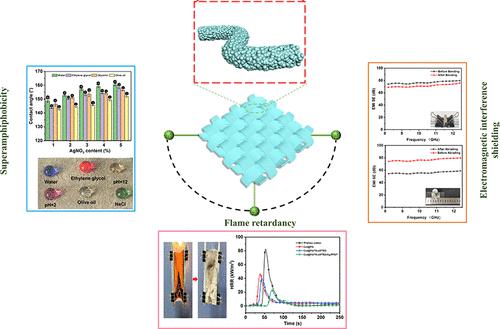当前位置:
X-MOL 学术
›
ACS Appl. Mater. Interfaces
›
论文详情
Our official English website, www.x-mol.net, welcomes your feedback! (Note: you will need to create a separate account there.)
Multifunctional Superamphiphobic Cotton Fabrics with Highly Efficient Flame Retardancy, Self-Cleaning, and Electromagnetic Interference Shielding
ACS Applied Materials & Interfaces ( IF 8.3 ) Pub Date : 2023-01-03 , DOI: 10.1021/acsami.2c21320 Xiao Gong 1, 2 , Zheng Xiong 2 , Xiaona Chen 1 , Fanchao Meng 1 , Hangxiang Wang 1, 3
ACS Applied Materials & Interfaces ( IF 8.3 ) Pub Date : 2023-01-03 , DOI: 10.1021/acsami.2c21320 Xiao Gong 1, 2 , Zheng Xiong 2 , Xiaona Chen 1 , Fanchao Meng 1 , Hangxiang Wang 1, 3
Affiliation

|
Here, a facile method is reported to prepare multifunctional cotton fabrics with high flame retardancy, high electrical conductivity, superamphiphobicity, and high electromagnetic shielding. The cotton fabric surface was first modified with phytic acid (PA), which promoted dehydration and carbonization of cellulose to increase flame retardancy in the process of pyrolysis. Tannic acid (TA) and 3-aminopropyltriethoxysilane (APTES) coating with nanospheres as interlayers created hierarchical roughness that facilitated the construction of superamphiphobic surfaces and provided adhesion sites for silver nanoparticles. In addition, the TA-APTES coating improved flame retardancy because the APTES-containing silicon could form silicon carbon layers to isolate heat and oxygen. Subsequently, the surface energy of the composite cotton fabric was reduced by fluorine-containing molecules. The prepared composite cotton fabric exhibited excellent superamphiphobicity with contact angles of 160.3 and 152° for water and olive oil, respectively. The conductivity and EMI shielding efficiency of the prepared composite cotton fabric reached 629.93 S/cm and 76 dB, respectively. Importantly, the composite cotton fabric maintained a relatively stable EMI shielding efficiency even after cyclic bending and abrasion tests. Moreover, the composite cotton fabric possessed a high limiting oxygen index (LOI) of 45.3% and self-extinguishing properties with the peak heat release rate (PHHR) and total heat release (THR) reduced by 73 and 67%, respectively, than the pure cotton fabric, indicating the outstanding flame retardancy.
中文翻译:

具有高效阻燃、自清洁和电磁干扰屏蔽功能的多功能超双疏棉织物
在这里,报道了一种制备具有高阻燃性、高导电性、超双疏性和高电磁屏蔽性的多功能棉织物的简便方法。首先用植酸(PA)对棉织物表面进行改性,在热解过程中促进纤维素的脱水和碳化以增加阻燃性。以纳米球作为中间层的单宁酸 (TA) 和 3-氨基丙基三乙氧基硅烷 (APTES) 涂层产生了分级粗糙度,促进了超双疏表面的构建,并为银纳米颗粒提供了粘附位点。此外,TA-APTES 涂层提高了阻燃性,因为含 APTES 的硅可以形成硅碳层以隔离热量和氧气。随后,含氟分子降低了复合棉织物的表面能。制备的复合棉织物表现出优异的超双疏性,水和橄榄油的接触角分别为 160.3 和 152°。制备的复合棉织物的导电率和EMI屏蔽效率分别达到629.93 S/cm和76 dB。重要的是,即使经过循环弯曲和磨损测试,复合棉织物也能保持相对稳定的 EMI 屏蔽效率。此外,复合棉织物具有45.3%的高极限氧指数(LOI)和自熄性能,峰值放热率(PHHR)和总放热率(THR)分别比复合棉织物降低73%和67%。纯棉面料,阻燃性能突出。制备的复合棉织物表现出优异的超双疏性,水和橄榄油的接触角分别为 160.3 和 152°。制备的复合棉织物的导电率和EMI屏蔽效率分别达到629.93 S/cm和76 dB。重要的是,即使经过循环弯曲和磨损测试,复合棉织物也能保持相对稳定的 EMI 屏蔽效率。此外,复合棉织物具有45.3%的高极限氧指数(LOI)和自熄性能,峰值放热率(PHHR)和总放热率(THR)分别比复合棉织物降低73%和67%。纯棉面料,阻燃性能突出。制备的复合棉织物表现出优异的超双疏性,水和橄榄油的接触角分别为 160.3 和 152°。制备的复合棉织物的导电率和EMI屏蔽效率分别达到629.93 S/cm和76 dB。重要的是,即使经过循环弯曲和磨损测试,复合棉织物也能保持相对稳定的 EMI 屏蔽效率。此外,复合棉织物具有45.3%的高极限氧指数(LOI)和自熄性能,峰值放热率(PHHR)和总放热率(THR)分别比复合棉织物降低73%和67%。纯棉面料,阻燃性能突出。水和橄榄油分别为 3 和 152°。制备的复合棉织物的导电率和EMI屏蔽效率分别达到629.93 S/cm和76 dB。重要的是,即使经过循环弯曲和磨损测试,复合棉织物也能保持相对稳定的 EMI 屏蔽效率。此外,复合棉织物具有45.3%的高极限氧指数(LOI)和自熄性能,峰值放热率(PHHR)和总放热率(THR)分别比复合棉织物降低73%和67%。纯棉面料,阻燃性能突出。水和橄榄油分别为 3 和 152°。制备的复合棉织物的导电率和EMI屏蔽效率分别达到629.93 S/cm和76 dB。重要的是,即使经过循环弯曲和磨损测试,复合棉织物也能保持相对稳定的 EMI 屏蔽效率。此外,复合棉织物具有45.3%的高极限氧指数(LOI)和自熄性能,峰值放热率(PHHR)和总放热率(THR)分别比复合棉织物降低73%和67%。纯棉面料,阻燃性能突出。即使经过循环弯曲和磨损测试,复合棉织物仍保持相对稳定的 EMI 屏蔽效率。此外,复合棉织物具有45.3%的高极限氧指数(LOI)和自熄性能,峰值放热率(PHHR)和总放热率(THR)分别比复合棉织物降低73%和67%。纯棉面料,阻燃性能突出。即使经过循环弯曲和磨损测试,复合棉织物仍保持相对稳定的 EMI 屏蔽效率。此外,复合棉织物具有45.3%的高极限氧指数(LOI)和自熄性能,峰值放热率(PHHR)和总放热率(THR)分别比复合棉织物降低73%和67%。纯棉面料,阻燃性能突出。
更新日期:2023-01-03
中文翻译:

具有高效阻燃、自清洁和电磁干扰屏蔽功能的多功能超双疏棉织物
在这里,报道了一种制备具有高阻燃性、高导电性、超双疏性和高电磁屏蔽性的多功能棉织物的简便方法。首先用植酸(PA)对棉织物表面进行改性,在热解过程中促进纤维素的脱水和碳化以增加阻燃性。以纳米球作为中间层的单宁酸 (TA) 和 3-氨基丙基三乙氧基硅烷 (APTES) 涂层产生了分级粗糙度,促进了超双疏表面的构建,并为银纳米颗粒提供了粘附位点。此外,TA-APTES 涂层提高了阻燃性,因为含 APTES 的硅可以形成硅碳层以隔离热量和氧气。随后,含氟分子降低了复合棉织物的表面能。制备的复合棉织物表现出优异的超双疏性,水和橄榄油的接触角分别为 160.3 和 152°。制备的复合棉织物的导电率和EMI屏蔽效率分别达到629.93 S/cm和76 dB。重要的是,即使经过循环弯曲和磨损测试,复合棉织物也能保持相对稳定的 EMI 屏蔽效率。此外,复合棉织物具有45.3%的高极限氧指数(LOI)和自熄性能,峰值放热率(PHHR)和总放热率(THR)分别比复合棉织物降低73%和67%。纯棉面料,阻燃性能突出。制备的复合棉织物表现出优异的超双疏性,水和橄榄油的接触角分别为 160.3 和 152°。制备的复合棉织物的导电率和EMI屏蔽效率分别达到629.93 S/cm和76 dB。重要的是,即使经过循环弯曲和磨损测试,复合棉织物也能保持相对稳定的 EMI 屏蔽效率。此外,复合棉织物具有45.3%的高极限氧指数(LOI)和自熄性能,峰值放热率(PHHR)和总放热率(THR)分别比复合棉织物降低73%和67%。纯棉面料,阻燃性能突出。制备的复合棉织物表现出优异的超双疏性,水和橄榄油的接触角分别为 160.3 和 152°。制备的复合棉织物的导电率和EMI屏蔽效率分别达到629.93 S/cm和76 dB。重要的是,即使经过循环弯曲和磨损测试,复合棉织物也能保持相对稳定的 EMI 屏蔽效率。此外,复合棉织物具有45.3%的高极限氧指数(LOI)和自熄性能,峰值放热率(PHHR)和总放热率(THR)分别比复合棉织物降低73%和67%。纯棉面料,阻燃性能突出。水和橄榄油分别为 3 和 152°。制备的复合棉织物的导电率和EMI屏蔽效率分别达到629.93 S/cm和76 dB。重要的是,即使经过循环弯曲和磨损测试,复合棉织物也能保持相对稳定的 EMI 屏蔽效率。此外,复合棉织物具有45.3%的高极限氧指数(LOI)和自熄性能,峰值放热率(PHHR)和总放热率(THR)分别比复合棉织物降低73%和67%。纯棉面料,阻燃性能突出。水和橄榄油分别为 3 和 152°。制备的复合棉织物的导电率和EMI屏蔽效率分别达到629.93 S/cm和76 dB。重要的是,即使经过循环弯曲和磨损测试,复合棉织物也能保持相对稳定的 EMI 屏蔽效率。此外,复合棉织物具有45.3%的高极限氧指数(LOI)和自熄性能,峰值放热率(PHHR)和总放热率(THR)分别比复合棉织物降低73%和67%。纯棉面料,阻燃性能突出。即使经过循环弯曲和磨损测试,复合棉织物仍保持相对稳定的 EMI 屏蔽效率。此外,复合棉织物具有45.3%的高极限氧指数(LOI)和自熄性能,峰值放热率(PHHR)和总放热率(THR)分别比复合棉织物降低73%和67%。纯棉面料,阻燃性能突出。即使经过循环弯曲和磨损测试,复合棉织物仍保持相对稳定的 EMI 屏蔽效率。此外,复合棉织物具有45.3%的高极限氧指数(LOI)和自熄性能,峰值放热率(PHHR)和总放热率(THR)分别比复合棉织物降低73%和67%。纯棉面料,阻燃性能突出。






































 京公网安备 11010802027423号
京公网安备 11010802027423号